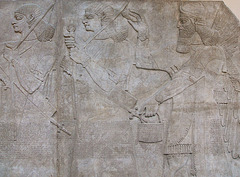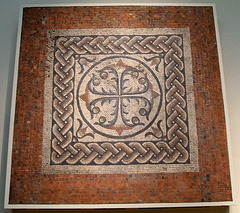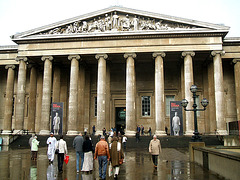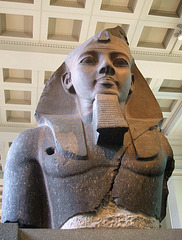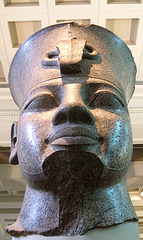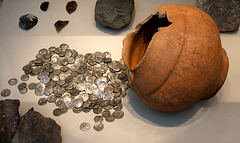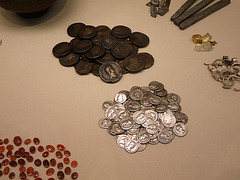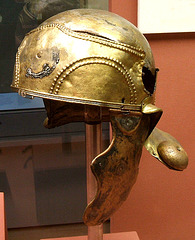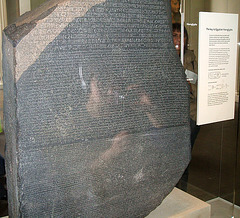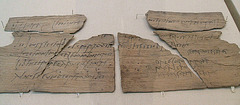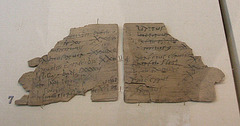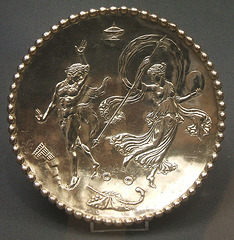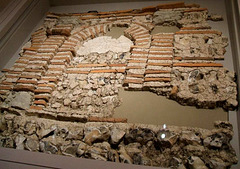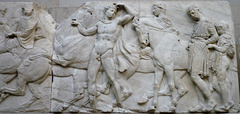
British Museum
Folder: Places
Pictures taken at the British Museum, London.
AssyrianRelief (65BC)
Bank of England Mosaic
| |
|
3rd century AD
Found under the Bank of England, London
This floor of a small square room was the first Romano-British mosaic acquired by the British Museum, in 1806, about a year after its discovery. It lay around 3.5 metres underground under the north-west corner of the Bank of England site in the City of London.
In the British Museum.
October 2007.
BritishMuseum
Bust of Ramesses II
GreatCourt - BritishMuseum
| |
|
The museum's Great Court is the largest covered public square in Europe.
October 2007.
Head of Amenhotep III
Horned Helmet
| |
|
This 'helmet' was dredged from the River Thames at Waterloo Bridge in the early 1860s. It is the only Iron Age helmet to have ever been found in southern England, and it is the only Iron Age helmet with horns ever to have been found anywhere in Europe.
In the British Museum.
October 2007.
Iceni Hoard
| |
|
Found at Field Baulk, March, Cambridgeshire (1982).
This hoard consists of 872 silver coins of the Iron Age Iceni tribe of East Anglia, and is the the largest single Icenian find yet known. The coins were contained in the globular pot, which was probably made sometime between AD 50 and 70. The hoard was hidden below ground, in a settlement, and the reason for its concealment may have been the troubled times of AD 60-61, when Queen Boudica led a tribal revolt against the newly-established Roman rulers.
In the British Museum.
October 2007.
Jeweller's Hoard
| |
|
This hoard, found during building work in 1985, represents part of the stock of a jeweller working in the area in the second century AD. There are 110 coins in the hoard, 83 silver and 27 bronze. The silver coins (mostly denarii of Domitian) were almost certainly being melted down for conversion into jewellery. All the engraved gems (117) are of carnelian.
In the British Museum.
October 2007.
Military Diploma
| |
|
This official certificate is inscribed on two joining bronze plates. It was issued by the Roman emperor Trajan (AD 98-117) to Reburrus, a Spanish decurion (junior officer) in the 1st Pannonian cavalry regiment.
It granted him Roman citizenship and the right of legal marriage with a present or future wife. These privileges were usually granted to the non-citizen auxiliary soldiers when they retired after completing the twenty-five year period of military service.
From Malpas, Cheshire.
In the British Museum.
October 2007.
Roman Cavalry Helmet
| |
|
1st century AD - From Witcham Gravel, Ely, Cambridgeshire.
The helmet would have protected the wearer's head with an inner iron head-piece and neck-guard, which are now largely missing. Though the small bosses would have helped deflect blows from weapons, the outer bronze casing is mostly decorative.
The crest box, one cheek-piece and several of the bosses are now missing.
In the British Museum.
October 2007.
RosettaStone
| |
|
The inscription on the Rosetta Stone is a decree passed by a council of priests, the decree is inscribed on the stone three times, in hieroglyphic, demotic (a native Egyptian script) and classical Greek. The importance of this to Egyptology is immense. Soon after the end of the 4th century AD, when hieroglyphs had gone out of use, the knowledge of how to read and write them disappeared. In the early years of the 19th century, scholars were able to use the Greek inscription on this stone as the key to decipher them.
In the British Museum.
October 2007.
Vindolanda Tablet 2
| |
|
These tablets are the oldest surviving examples of handwriting in Britain, and were found on the site of the Vindolanda Roman fort in Northeast England. There are hundreds of fragments altogether, written on thin pieces of wood. They date from about 100AD.
This particular one is a birthday invitation, written by a woman asking her friend to a party.
"Claudia Severa to her Lepidina greetings. On 11 September, sister, for the day of the celebration of my birthday, I give you a warm invitation to make sure that you come to us, to make the day more enjoyable for me by your arrival, if you are present (?). Give my greetings to your Cerialis. My Aelius and my little son send him (?) their greetings.
(Second hand) I shall expect you, sister. Farewell, sister, my dearest soul, as I hope to prosper, and hail. "
In the British Museum.
October 2007.
Vindolanda Tablet 1
| |
|
These tablets are the oldest surviving examples of handwriting in Britain, and were found on the site of the Vindolanda Roman fort in Northeast England. There are hundreds of fragments altogether, written on thin pieces of wood. They date from about 100AD.
This tablet contains an account that may have been that of a civilian trader doing business with soldiers.
The text lists cash sums usually for specific goods, written in two columns - some entries have been scored through, implying that they have been paid.
In the British Museum.
October 2007.
Mildenhall Small Plate
| |
|
|
|
The Mildenhall hoard is one of the most important collections of late-Roman silver tableware from the Roman Empire. The objects were found during ploughing near Mildenhall in Suffolk, eastern England, in 1942 and were declared Treasure Trove in 1946. Although no coins were found to give a reliable date, the tableware's style and decoration is typical of the fourth century AD. This picture shows one of the pieces, a small plate.
In the British Museum.
October 2007.
Roman Tombstone
| |
|
This is the reconstructed tombstone of Gaius Julius Alpinus Classicianus. His name shows him to have been a member of the Gallic aristocracy, but we know more about him from the Roman historian Tacitus (Annals XIV 38-39), an unusual instance where we can link a documented person to a burial monument. Nero (reigned AD 54-68) appointed Classsicianus as the procurator (finance minister) of Britain after the revolt of the Iceni led by Queen Boudica in AD 60-61. His job was to correct the financial abuses that had been an important cause of the rebellion.
In late Roman times (fourth century AD), pieces of the tombstone were re-used in the hurried construction of one of the bastions that protected the walls of Roman London. The first surviving pieces came to light in 1852; further sections were discovered in 1885, when an underground railway was cut through the site, and in 1935.
DIS [M]ANIBVS [C(AI) IVL(I) C(AI) F(ILI) F]AB(IATRIBV) ALPINI CLASSICIANI PROC(VRATORIS) PROVINC(IAE) BRIT[ANNIAE] IVLIA INDI FILIA PACATA I[NDIANA] VXOR [F(ECIT)]
To the spirit of the departed Gaius Julius, son of Gaius, of the Fabian voting tribe, Alpinus Classicianus … procurator of the province of Britannia. Julia Pacata, daughter of Indus, I…, his wife set this up.
(RIB 12).
In the British Museum.
October 2008.
Meonstoke Roman Villa
| |
|
|
|
This is a section of the façade of an aisled barn-like building on a villa estate in the parish of Meonstoke, Hampshire. It was excavated by King Alfred's College, Winchester and lifted by The British Museum in 1989. The façade was constructed in the early fourth century AD. We know that it collapsed some time after AD 353, as that is the latest date of the coins found underneath.
In the British Museum.
December 2007.
Parthenon Sculptures
| |
|
447-432BC
The Parthenon was built as a temple dedicated to the goddess Athena. It was the centrepiece of an ambitious building programme on the Acropolis of Athens around 2500 years ago.
The building was altered and the sculptures much damaged over the course of the centuries. The first major loss occurred around AD 500 when the Parthenon was converted into a church. When the city was under siege by the Venetians in 1687, the Parthenon itself was used as a gunpowder store. A huge explosion blew the roof off and destroyed a large portion of the remaining sculptures. The building has been a ruin ever since.
By 1800 only about half of the original sculptural decoration remained. Between 1801 and 1805 Lord Elgin, the British ambassador to the Ottoman Empire, of which Athens had been a part for some 350 years, acting with the full knowledge and permission of the Ottoman authorities, removed about half of the remaining sculptures from the fallen ruins and from the building itself and transported them back to Britain. The arrival of the sculptures in London had a profound effect on the European public, regenerating interest in ancient Greek culture and influencing contemporary artistic trends. These sculptures were acquired from Lord Elgin by the British Museum in 1816.
British Museum, London.
April 2013.
Jump to top
RSS feed- Latest items - Subscribe to the latest items added to this album
- ipernity © 2007-2024
- Help & Contact
|
Club news
|
About ipernity
|
History |
ipernity Club & Prices |
Guide of good conduct
Donate | Group guidelines | Privacy policy | Terms of use | Statutes | In memoria -
Facebook
Twitter

